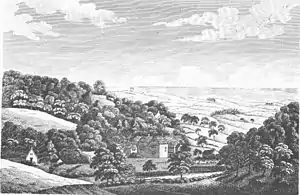Maurice Bocland (British Army officer)
Lieutenant-General Maurice Bocland (c. 1695 – 15 August 1765) was a British soldier and Member of Parliament.
Biography
He was the second son of Maurice Bocland of Standlynch, by his wife Mabel, daughter of Sir Robert Dillington, 2nd Baronet of Knighton. He was commissioned as a cornet in the 5th Dragoon Guards in 1715, and was promoted to lieutenant in 1716 and captain-lieutenant in the 1st Dragoon Guards in 1719.
Bocland succeeded to the family estate in Wiltshire on the death of his brother Philip, but sold it in 1726 and moved to Hampshire. He was first elected to Parliament for Yarmouth at a by-election in 1733, then for Lymington at the general election in 1734, for Yarmouth again in 1741, and for Newport in 1747. In Parliament he supported the Government.
In his military career, Bocland transferred from the cavalry to the infantry in 1738, when he was promoted to captain in the 1st Regiment of Foot Guards, ranking as a lieutenant-colonel. He served in the War of the Austrian Succession in Flanders from 1743 to 1746; he was wounded at the Battle of Fontenoy in 1745[1] and promoted to major in the same year. In 1747 he was made colonel of the 11th Regiment of Foot,[2] an appointment he would hold until his death.

Bocland succeeded his maternal aunt to the estate of Knighton in 1749, and was made Captain of Carisbrooke Castle in 1752. He was not elected to Parliament in the general election of 1754, but continued his advance in the Army with promotion to major-general in 1755[3] and lieutenant-general in 1758.[4]
By his first wife, Jane Fox, Bocland had five sons and two daughters before she died on 25 February 1741. On 4 November that year he married Sophia, daughter of Major Bisset of Southampton, with no children. Knighton Gorges passed to his nephew George Maurice Bissett who deliberately burnt the house down in 1820 to deny his daughter her inheritance.
References
- Paula Watson, BOCLAND, Maurice (c.1695-1765), of Lymington, Hants. in The History of Parliament: the House of Commons 1715-1754 (1970).
- "No. 8430". The London Gazette. 7–11 May 1745. p. 8.
- "No. 8698". The London Gazette. 1–5 December 1747. p. 1.
- "No. 9459". The London Gazette. 15–18 March 1755. p. 2.
- "No. 9759". The London Gazette. 21–24 January 1758. p. 1.
| Parliament of Great Britain | ||
|---|---|---|
| Preceded by Maurice Morgan Paul Burrard |
Member of Parliament for Yarmouth 1733–1734 With: Paul Burrard |
Succeeded by Paul Burrard Lord Harry Powlett |
| Preceded by Lord Nassau Powlett William Powlett |
Member of Parliament for Lymington 1734–1741 With: Sir John Cope |
Succeeded by Lord Nassau Powlett Harry Burrard |
| Preceded by Thomas Gibson Anthony Chute |
Member of Parliament for Yarmouth 1741–1747 With: Thomas Gibson 1741–1744 Robert Carteret 1744–1747 |
Succeeded by Thomas Holmes Henry Holmes |
| Preceded by Henry Holmes Sir John Barrington |
Member of Parliament for Newtown 1747–1754 With: Sir John Barrington |
Succeeded by Sir John Barrington Harcourt Powell |
| Military offices | ||
| Preceded by William Graham |
Colonel of the 11th Regiment of Foot 1747–1765 |
Succeeded by William A'Court Ashe |